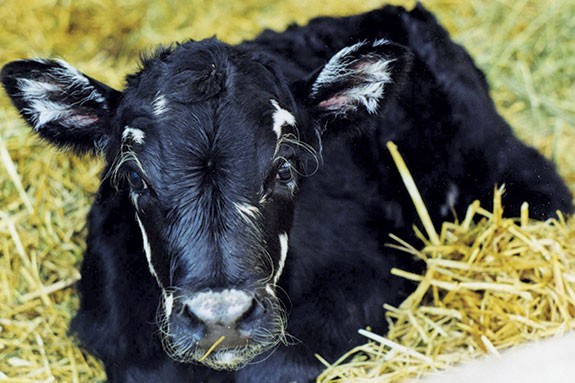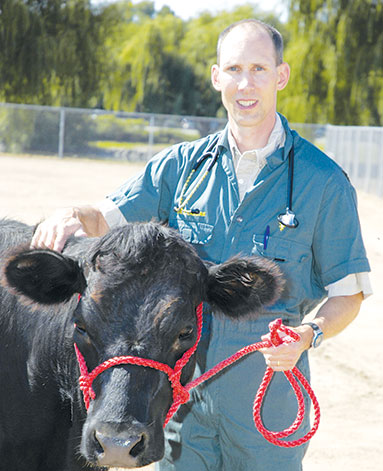Gestation length is partly a matter of genetics: Some cattle have longer or shorter gestation, and this is a big factor in calving ease.
Cattle with long gestation lengths generally give birth to large calves, since the fetus is growing fastest at the end of gestation.
A 278-day gestation usually results in a smaller, lighter calf (in the same breed and type of animal) than a calf carried 288 days or longer. One study showed that each extra day of gestation adds a pound or more in size of the calf.
One reason bull calves are often larger than heifer calves is that they tend to be carried longer (partly due to hormonal factors). A cow that calves a few days before her estimated due date often gives birth to a heifer, whereas a cow that goes overdue often has a bull calf.
But some cows always calve earlier or later than their projected date and some bulls sire calves that are always born earlier or later.
Buddy Westphal, a Charolais breeder at Valley View Charolais Ranch near Polson, Montana, has been interested in gestation length for many years – particularly as it applies to calving ease and giving cows more time to recover and breed back.
“When I bought this ranch in the late 1960s, the Charolais cows on the place were A.I.-bred to some French bulls that were popular at that time. I moved onto the place just as the cows were starting to calve,” he says.
“I’d note that a certain cow was bred on a certain date and should calve on such-and-such day. As I was waiting, 283 days would pass, and 10 days later I’d be still waiting and thinking she was bred to the clean-up bull.
About 15 days later she had a 140-pound calf and it’s obvious it’s not by the clean-up bull – it’s that many days late. When a cow calves 10 days or two weeks late (and has a big calf and a hard birth), she’s losing that amount of time to recover and rebreed.
So I started looking for bulls that sired calves with shorter gestation so I could get my cows bred back on time,” he says.
“I went to the Canadian Conception to Consumer test, where they verified bulls through their testing program. They had exact gestation lengths on all of them. I was looking for Charolais bulls that had 283-day-or-less average gestation length.

I found some that fit that category and started using those. Instead of siring a 140-pound calf, they’d sire an 80-pound calf and it would be born a lot easier,” he says.
Fetal development and rate of maturation (determining when the calf reaches full term and triggers labor) is influenced by his genetics.
If both sire and dam have short gestation genetics, the calf will be born earlier. If either the sire or dam has genetics for a longer gestation, results may be mixed, depending on which trait is inherited by the calf.
The cow may calve ahead of or later than her projected due date and it can sometimes be a challenge to predict when she’ll calve.
There are some clues, however. As a cow or heifer nears the end of gestation, her body makes changes to aid the birth process. One of the first signs of approaching calving is development of her udder.
It may begin enlarging as early as six weeks before she calves (especially in heifers) or may suddenly fill during the last few days.
Some cows and heifers have so much udder development that you think calving is imminent, but they go many more days before the actual event. Others “bag up” overnight and can fool you; they may calve before you realize they are ready.
One clue that calving will take place within about 24 hours is the teats filling. Even if the udder has been large for many days, the teats themselves often don’t become full and distended until the cow is nearly ready to calve.
Occasionally the plug in the end of the teat comes out, with secretion on the end of the teat.
Other signs of impending labor include mucus discharge from the vulva as the cervical plug/seal softens and is expelled. A long string of mucus may hang from the vulva.
Tissues around the birth canal become soft; the vulva is enlarged and flabby. The floppy vulva is a sign the cow or heifer is approaching calving, but she can still keep you guessing because some individuals are loose and floppy for several weeks.
The pelvic ligaments also relax. The area between tail head and point of the buttock (pin bone) on each side of the tail appears somewhat sunken. Labor will usually begin about 12 hours after complete relaxation of those ligaments.
If your cows are gentle enough to let you walk up and scratch them, you can feel the pelvic ligaments next to the tail head. This is one of the surest ways to predict calving.
These ligaments are about an inch in diameter, connecting the pin bones to the spine. They attach to the vertebrae just ahead of where the tail starts and are easily visible on most dairy cows and on thin beef cows.
On a fleshy beef cow, you can’t see them – but you can feel them. The ligaments are normally hard and tight, except for a few hours before labor begins and just after calving.
They loosen up as part of the process that enables the birth canal to expand so the calf can come through. If they are soft and spongy, the cow will calve soon.
If you have breeding dates (from A.I. or observing cows during breeding season), you have an estimated “due date.”
But sex of the calf, age of the cow, season of year (summer calves often come a few days earlier than winter calves), heritability of gestation length or nutrition of the dam can all be factors in whether calves come ahead of or after that date.
Weather also makes a difference. There is often a flurry of calving just before a storm. The calves that might have arrived over a several-day period will all come at once.
When the barometer is falling, you can expect a lot of calves. Many cows that are ready to calve begin labor in a low-pressure period rather than when the barometer is rising.
It is common to have an abnormally high number of cows calve just before the storm and less calving activity in the herd for the next 48 hours.
Heather Thomas is a freelance writer based in Idaho.

Technology aids predictions
Dr. Rob Callan of Colorado State University says research shows that pregnant cows undergo a drop in body temperature during the 12 to 24 hours preceding calving.
“This can be monitored with temperature sensor boluses,” he says.
The bolus is placed in the reticulum, similarly to how a magnet is put into the cow, and it transmits temperature, which is picked up by a receiver.
“Temperature transmitters are useful for detecting fever and early stages of illness and could also be a way to flag cows that might be in early labor, watching for a drop in temperature.
Temperature research, relative to calving, is still in its infancy in developing appropriate algorithms, but the technology is there,” he says. These boluses were first designed for heat stress research.
When cows can be kept in close proximity to a receiver for the transmitted signals, this could be a way to detect temperature drop as a clue for calving.
“DVM Systems here in Colorado market these primarily for dairy cattle and one of their temperature boluses costs about $40.
But this might be an option for genetically valuable beef seedstock. These boluses would probably last the life of the cow,” says Callan.
This is still in the research phase but might be an option if the boluses become less expensive. Some breeders have also used various types of calving alert systems, similar to those used in mares.
Ultrasound
If you don’t know the breeding date on a cow, use of ultrasound for pregnancy testing can be helpful to determine stage of gestation.
People who palpate a lot of cows are also quite accurate in assessing the age of the fetus, but ultrasound is considered the best.
“A good ultrasound operator can nail the age of the fetus with extreme accuracy. Every purebred breeder should do this (it’s handy for knowing the sex of the calf as well as confirming the breeding date), and I recommend it for commercial breeders.
Even if the cow is pregnant, if you realize she’s going to calve later than the rest of the herd, you might decide to sell her,” says Westphal.
Night feeding
Some stockmen try to manipulate calving, hoping for a higher percent of calves born during daylight instead of at night.
Some claim that feeding the hay ration late at night makes for fewer calves born at night, with cows spending much of the night eating. Others who have tried it say it doesn’t make much difference.
PHOTOS
TOP: Watch the weather and keep an eye for a dropping barometer, which is a telltale sign for oncoming labor.
MIDDLE: Genetics play a key factor in fetal development and rate of maturation for a calf. Photos courtesy of Heather Thomas.
BOTTOM: Rob Callan of Colorado State University with one of his heifers. Photo courtesy of Rob Callan.








